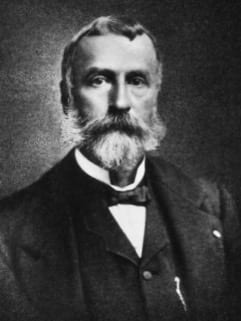Thomas George Morton
Thomas George Morton (1835-1903) was an American general surgeon.
Originally born in Philadelphia, he studied medicine at the University of Pennsylvania. He gained renown treating injured soldiers for the Union during the American civil war.
Morton served as head physician at the Pennsylvania Hospital (founded 100 years earlier by Benjamin Franklin and Thomas Bond) and published several volumes on the hospital’s history, including a compendium of his notable surgical cases and operations. He was an early advocate of observing strict anti-sepsis in surgery, as can be seen in his operation notes.
In April 1887 he reported on a 26-year-old paper-hanger whom he correctly diagnosed with an inflamed appendix. The subsequently performed open appendicectomy was the first of it’s kind with the patient surviving to discharge.
Though there is little personal information on him, it can be assumed Morton held progressive views for his time: He was the first president of the American Anti-Vivisection society (which still exists today)- advocating for the curtailing and restriction of experimentation on animals in the medical and scientific communities. He also founded the first society for the Protection of Children from Cruelty.
Eponyms include Morton’s neuroma; Morton’s neuralgia and Morton’s metatarsalgia
Biography
- Born August 8, 1835, Philadelphia
- 1856 – Graduated in Medicine, University of Pennsylvania
- 1862-1865 Surgeon during the Civil War at Philadelphia’s Satterlee United States Army General Hospital and at the Chestnut Hill United States Army Hospital
- Performed the first appendectomy for correctly diagnosed appendicitis
- Died May 20, 1903 of cholera aged 68
Laparotomy for perforative appendicitis, with removal of the organ, is now an established surgical procedure, and yet so recently has this operation been introduced that I am able to present the patient upon whom I operated in April, 1887, for pericecal abscess with peritonitis, which I believe represents the first successful operation for the removal of the vermiform appendix in a case of this kind, based upon correct diagnosis.
Morton TG, 1890
Medical Eponyms
Morton metatarsalgia (1876)
In 1876 Morton described a series of 15 patients of his own and one of a colleague who all shared the same complaints, which he termed metatarsalgia and which he attributed to an injury to the fourth metatarsophalangeal joint.
In March, 1873, was asked to see Miss H.S., aged 26 years, who while in Europe four years before, had injured her right foot by stepping upon a small stone. She said that she had at once experienced intense pain, which was soon followed by slight swelling and redness…The pain was referred to the head of the fourth metatarsal bone.
Morton TG, 1886
- Morton neuroma – benign, perineural fibrotic lesion of a common digital nerve
- Morton neuralgia, metatarsalgia (1876)
Controversies
In 1835, Filippo Civinini of Pistoja (1805-1844) described in the anatomic letter entitled “Su un nervoso gangliare rigonfiamento alla pianta del piede” (“On the neural ganglion swelling of the foot sole“) – the fusiform (gangliare) swelling (rigonfiamento) in the common plantar digital nerve to the third interspace. However there was no clinical description (metarsalgia) involved in this report.
Review of the historical writings demonstrates that Morton did not describe a painful condition related to a common plantar digital nerve of any web space but rather a painful condition related to the fourth metatarsophalangeal joint. He treated this painful condition by resection of the joint and the nerves, probably on both sides of that joint.
Larson 2005
Major Publications
- Morton TG. A peculiar and painful affection of the fourth metatarso-phalangeal articulation. American Journal of the Medical Sciences. 1876; 71: 37–45.
- Morton TG. Clinical lecture cases of painful affection of the foot. Philadelphia Medical Times. 1886
- Morton TG. The history of the Pennsylvania Hospital, 1751-1895. Philadelphia: Times Printing House, 1895
- Morton TG, Hunt W, Roberts JB, Woodbury F. Surgery in the Pennsylvania Hospital. J.B. Lippincott & co. Philadelphia 1880
- Morton TG. On the antiseptic treatment of wounds. Clinical lectures delivered at the Pennsylvania Hospital on October 2 and 23, 1886. Philadelphia Medical Times. 1886
- Musser JH, Pepper W, Morton TG. Peri-caecal inflammation. Philadelphia: WM. J. Dornan, Printer. 1888
- Morton TG. Inflammation of the vermiform appendix: its results, diagnosis and treatment, together with the reports of seven cases of excision of the vermiform appendix for perforative appendicitis, with exhibition of five of the patients. J.B. Lippincott Company, Philadelphia. 1890
References
- Filippo Civinini. Su d’un nervoso gangliare rigonfiamento alla pianta del piede. 1835
- The second annual report of the American Anti-Vivisection Society. Philadelphia, 1885
- Larson EE, Barrett SL, Battiston B, Maloney CT Jr, Dellon AL. Accurate nomenclature for forefoot nerve entrapment. A historical perspective. Journal of the American Podiatric Medical Association 2005; 95(3): 298-306.
- G. Pasero, P. Marson. Filippo Civinini (1805-1844) and the discovery of plantar neuroma. Reumatismo 2006; 58(4): 319-22
- Gomez A, Cadogan M. Eponymythology of foot injuries. LITFL
[cite]
Resident medical officer in emergency medicine MB ChB (Uni. Dundee) MRCS Ed. Avid traveller, yoga teacher, polylinguist with a passion for discovering cultures.


